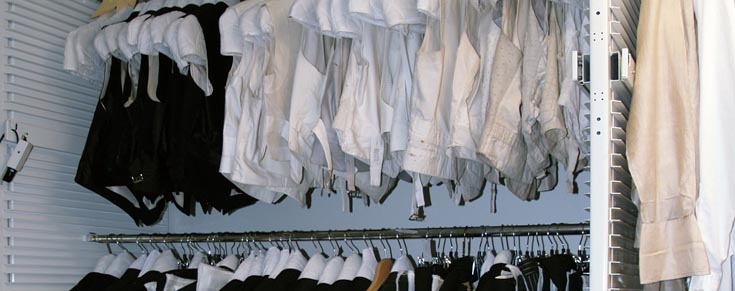
The Anne Lambert Clothing and Textiles Collection is named in honour of professor Anne Lambert who served as its Curator for 35 years. She played a pivotal role in establishing and growing this collection into one of profound international stature. In addition to her significant curatorial accomplishments, Professor Lambert has made an indelible impression on scores of students and colleagues who credit her as their mentor and inspiration for studying textiles and dress. Through her collection-based courses, students gained both knowledge and respect for the materials and objects of everyday life in addition to a rich understanding of how clothing and textiles are intimately connected to personal, social and cultural identities. She received the University of Alberta Museums' Hall of Fame Award in 2011. Through Professor Lambert's efforts and those of staff members who followed in her footsteps, the Collection has in its holdings unique kinds of artifacts.
Clothing and textiles are items that everyone has some familiarity with and that many people can relate to. It is also a multidisciplinary field of study where history, art, anthropology, sociology, and several more disciplines meet. While there are numerous art collections throughout the country, there are few collections dedicated to clothing and textiles and none other with the mission to collect, interpret and teach as an integral part of an undergraduate and graduate university program.
Scholarship Focus
Scholarship is a leading focus of the collection. The Royal Ontario Museum and the Clothing and Textiles Collection at the University of Alberta are the only two clothing and textile collections in Canada that have created scholarly structures where their curators hold doctorate degrees and teach as part of their functions. Students and the public thus benefit from the knowledge and experience of scholars who abide to the highest standards in the museum field.
The curator of The Clothing and Textile Collection at the University of Alberta, Dr. Anne Bissonnette, has created over 50 exhibitions in her career and has won international recognition for her work. In 2008, a series of three exhibitions on late eighteenth and early-nineteenth century fashion she curated received the Costume Society of America’s Richard Martin Award for Excellence in the Exhibition of Costume. In 2011, the exhibition "In Mother’s Hood: Inuit Packing Dolls from Taloyoak" she co-curated with an undergraduate history student, Christina Williamson, received a commendation from the jury of the Martin Award. In 2017, the exhibition "Eyewear: Fashion with Vision" she co-curated with undergraduate students in her HECOL 460 course became the first exhibition co-curated by students to receive a Martin Award. The University of Alberta is a leader within the world of higher education in its treatment of clothing and textiles. As a full professor in a research university, Dr. Bissonnette teaches classes on costume history, material culture, and museum curatorship using artifacts from the collection.
Many faculty members and students make artifacts from the Collection an integral part of their coursework. Vlada Blinova, Collection Manager and Faculty Service Officer, uses the collection in her apparel design classes, gives tours and caters to researchers’ needs. Undergraduate and graduate students at the master’s and PhD levels can also use artifacts to develop exhibitions. Dr. Beverly Lemire, a Henry Marshall Tory Chair in the Department of History & Classics also uses artifacts to advance research into human interaction with their environments and material goods. She also draws on the Collection in her courses and serves with faculty members in the Department of Human Ecology on the Collections Management Committee.
Storage Facility
The storage facility and care given to artifacts from the Collection are among the best in the world. Tours are given to visitors who marvel at the meticulous ways the safety and well-being of the artifacts are addressed: textiles are rolled under Mylar® covers or shielded from the light in custom-made acid-free portfolios, brims are supported on every hat mount and footwear placed in hand-carved receptacles. Each uniquely-designed storage mount is equipped with an acid-free cardboard base that reduces the need to handle the actual artifact it protects. Overseen by a professional conservator, such supports were developed by students who had to research and fabricate the best possible housing solution for the artifacts they were assigned to. A fully-equipped conservation laboratory helps the staff address the needs and fragile nature of the artifacts collected. Each artifact accepted is handled, supported and placed with the greatest of care in a state-of-the-art compact storage system housed in a temperature and humidity controlled environment.
The focus of the Collection, its place within a university setting that uses artifacts in undergraduate and graduate classes, the will to address the pieces in a scholarly manner and the utmost care that are given to objects make the Anne Lambert Clothing and Textiles Collection at the University of Alberta one of the most outstanding collections of its kind.
